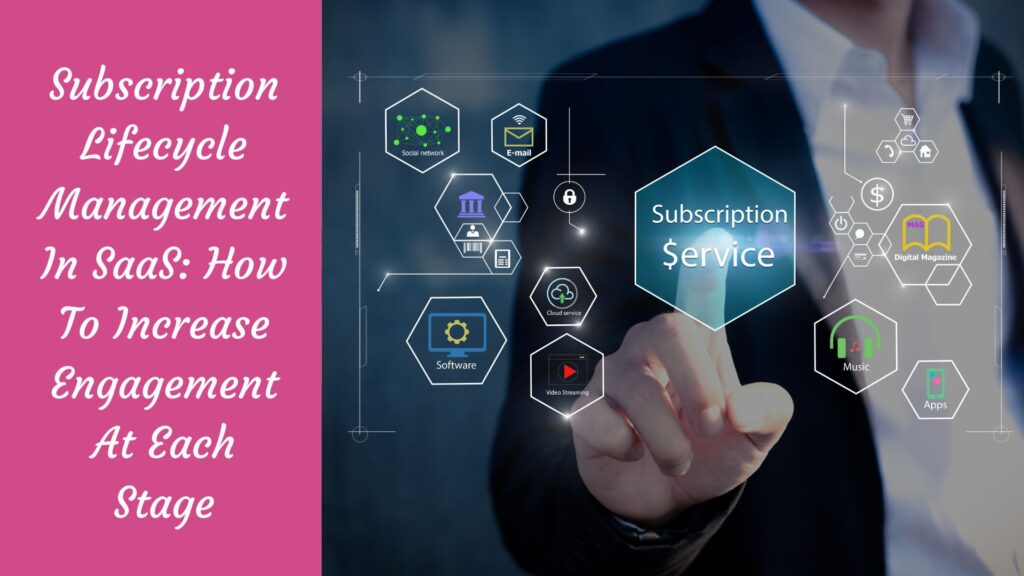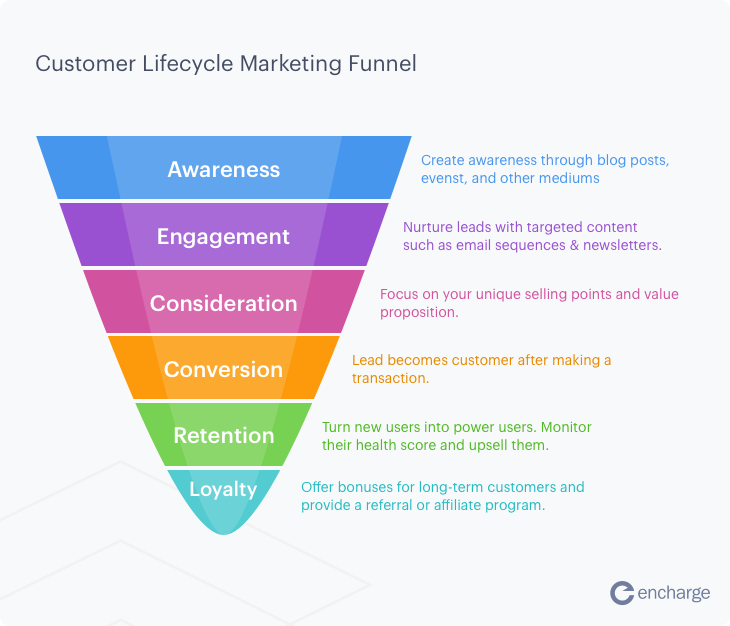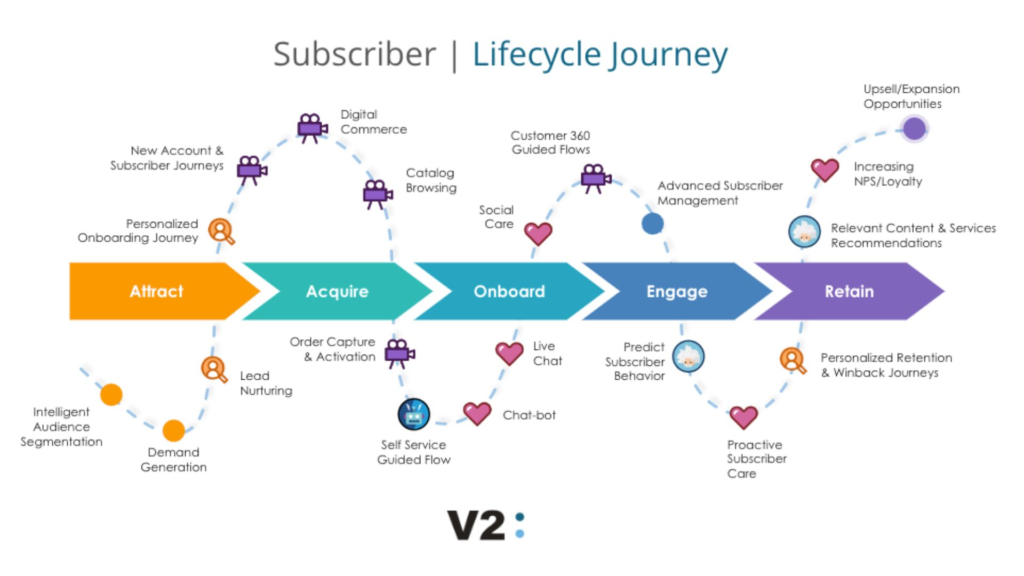The Software as a Service (SaaS) industry is booming, with an ever-growing number of companies adopting this model to provide customer software solutions. A unique characteristic of SaaS lies in its subscription business model, which enables continuous engagement and relationship with the customer.
Nurturing this relationship through subscription lifecycle management is critical to acquiring customers and turning them into loyal, raving fans. In this exhaustive guide, we will delve deep into the subscription lifecycle in SaaS and arm you with strategies to boost engagement at every step, from initial acquisition to expansion and beyond.
What is the customer lifecycle?
The lifecycle entails customers’ stages when considering, purchasing, using, and maintaining loyalty to a service or product. In SaaS, it can be segmented as follows:
- Awareness: The initial stage is when potential customers become aware of your SaaS offering. A prospect might come across a targeted ad on social media, read a blog post, or hear about the software through word-of-mouth. For instance, imagine an entrepreneur discovering a project management tool like Trello or Asana through a LinkedIn article on productivity.
- Consideration: At this juncture, the potential customer is evaluating your SaaS solution, among others. They will likely sign up for free trials, read reviews, or watch demo videos. For example, a small business owner could be in this phase, comparing QuickBooks and FreshBooks for their accounting needs.
- Conversion: Here, the customer decides and subscribes to your service. It is critical that the sign-up process is smooth and that there is an immediate value perceived. Think of a user choosing Spotify Premium for an uninterrupted, ad-free music experience.
- Retention: After conversion, keeping customers engaged and satisfied is essential to preventing churn. It could be through regular software updates, top-notch customer support, or valuable content. Picture Netflix suggests shows based on previous watch history to keep viewers engaged.
- Loyalty: Customers who stick with your product and become active advocates for your brand have entered the loyalty stage. They might recommend your product through referral programs or social media, like influencers endorsing Canva for its ease of creating stunning graphics.
- Expansion: Finally, we have the expansion stage, where loyal customers increase their investment in your service. It could be subscribing to a higher-tier plan or purchasing additional services. For instance, a user of Dropbox upgrades to Dropbox Business for enhanced features and more space.
Understanding these stages and the customer mindset at each one is integral to crafting a successful lifecycle engagement strategy.
What is customer lifecycle management?
Customer lifecycle management (CLM) in the SaaS arena is a strategic approach to managing & optimizing customer interactions at every stage. The goal is to nurture and strengthen the relationship with each customer, leading to increased satisfaction, loyalty, and revenue growth. Here are examples illustrating effective CLM in action:
- Onboarding Process: Immediately post-conversion, a company like Slack might use an interactive onboarding process with tooltips and guided tours to highlight features and encourage product usage.
- Communication Channels: Regular, personalized communication plays a pivotal role in CLM. Companies can stay connected with users through targeted email campaigns, online webinars, or social media interactions. For instance, Adobe sends regular emails with tips and the latest creative trends to keep users engaged with their Creative Cloud services.
- Customer Support: Zendesk, a customer service software company, exemplifies excellent customer support, a vital component of CLM, by providing 24/7 support and a comprehensive knowledge base, ensuring customers receive help whenever needed.
- Feedback Loops: Regular feedback collection, like SurveyMonkey does with its service, helps businesses understand customer pain points and preferences, which can inform product improvements. It is essential for tailoring the customer experience and enhancing satisfaction.
- Rewards and Recognition: Rewarding loyal customers can reinforce positive behavior; a SaaS company like Evernote offers referral points, which can be redeemed for premium features, encouraging retention and advocacy.
- Upsell and Cross-Sell Strategies: HubSpot excels at offering additional services and higher-tier plans to existing customers by demonstrating the added value these expansions provide over time.
By implementing a well-structured CLM, SaaS businesses aim to create more meaningful interactions, driving value for the company and its customers at each phase of the journey.
Subscription Lifecycle Management: An Overview
Before diving into strategies to enrich each stage of the subscriber journey, let’s understand the stages that comprise subscription lifecycle management. It’s similar to an extended sales funnel but uniquely tailored to the SaaS model:
- Acquisition: At this stage, potential customers become aware of your offering and consider subscribing. Marketing efforts play a crucial role here in converting visitors to sign-ups.
- Onboarding: Once acquired, new subscribers need to be onboarded effectively. It is where they start using your service and form an opinion about its value.
- Engagement: Regular utilization and active interaction with your service are the hallmarks of an engaged user. This stage focuses on strategies to maintain that engagement and prevent churn.
- Renewal: The renewal phase lets you delight your customers and ensure they continue their subscriptions. It is also the stage where you can collect valuable feedback for improvements.
- Expansion: Happy and engaged customers are more likely to be interested in advanced or additional features. Expansion is about upselling and cross-selling to increase the value of the customer and the relationship.
Now, let’s deep dive into each stage and understand how to enhance customer engagement.
Stage 1: Acquisition
The acquisition stage is the first touchpoint with potential customers. It’s where you must make a compelling case for why your SaaS is worth their time and money. Your goal here is to attract visitors and convert them into subscribers.
Crafting a Conversion-Driven Digital Presence
Your first impression may be your last, as the cliché goes, and this is never more true than in the digital world. The first step in successful acquisition is ensuring that any visitor to your site or landing page finds a message that resonates. It includes:
- Clear Value Proposition: Within seconds, visitors should understand the value your SaaS brings.
- Compelling Offers: Whether it’s a free trial, discounted first month, or bonus services, incentives can nudge a potential customer towards a subscription.
- Trust Signals: Testimonials, security badges, and industry certifications build trust and credibility.
- User-Centric Design: Make it easy for users to navigate your site, find the necessary information, and subscribe with minimal friction.
Optimizing Touchpoints for Sign-Ups
Conversion optimization isn’t just about driving traffic. It’s about making the most of every interaction with potential customers.
- A/B Testing: Continuously test elements such as headlines, images, and sign-up forms to see what converts better.
- Reducing Abandonment: Implement strategies like exit-intent popups and follow-up emails to recapture visitors about to leave.
- Simplify Sign-Up: The fewer fields in your sign-up forms, the better. Only ask for the information you need.
Stage 2: Onboarding
The onboarding process for a SaaS product is the make-or-break stage that can determine whether a new subscriber sticks around. It’s not just about features; it’s about successfully integrating your product into the customer’s workflow.
Personalization and User Education
During onboarding, personalization is key. Understand customers’ needs and guide them to features that provide immediate value.
- Welcome Emails: These should be personalized and give clear direction on what to do next.
- Guided Tours: Interactive tours that walk users through the main features.
- Help Docs and Videos: Provide resources that educate users on how to use the product, why they should use it, and how it will improve their lives.
Ensuring a Frictionless Start
Friction in the onboarding process can deter new subscribers.
- Software Walk-Through: Ensure the UI is intuitive and the onboarding process is simple.
- Fast Implementation: The quicker users can experience the value of your product, the better.
- Customer Support: Make support easily available for users who might get stuck.
Stage 3: Engagement
Engagement is all about keeping users active within your SaaS product. Regular use and interaction breed familiarity and point to a successful subscription service.
Implementing Gamification
Gamification leverages human psychology to encourage engagement through fun, game-like elements.
- Milestones and Achievements: Celebrate with your users as they reach certain usage goals.
- Interactive Content: Regularly update and refresh content or features users can interact with.
- Leaderboards: Use a sense of community and competition among users.
Building a Community and Gathering Feedback
A community can provide a wealth of insights and encourage engagement.
- Forums and Social Media: Create spaces for users to connect, share tips, and provide support.
- Surveys and Feedback Forms: Engage users in shaping the future of the product by seeking their opinions.
- Strategic Content: Provide user-focused content that adds value and keeps users returning for more.
Stage 4: Renewal
In the SaaS world, the renewal stage is where the health and satisfaction of your customer relationship become apparent. Retaining customers is significantly cheaper than acquiring a new one, so it’s a stage you can’t afford to neglect.
Proactive Customer Support and Quality Service
Good service is expected. Great service is memorable.
- Proactive Check-Ins: Don’t wait for the customer to come to you. Reach out to see if there’s anything they need.
- Quality Support: Provide quick, efficient solutions to any issues customers encounter.
- Regular Updates and Improvements: Keeping your service competitive and up-to-date is essential for retaining customers.
Feedback Collection and Actionable Insights
Understanding why customers might be considering not renewing is crucial.
- Net Promoter Score (NPS) Surveys: A simple and effective way to gauge overall satisfaction and likelihood to recommend your service.
- In-App Surveys: Break the barrier to collecting feedback by doing so within the product itself.
- Personalized Outreach: Follow up on feedback to let customers know their voice has been heard.
Stage 5: Expansion
You can focus on expansion once you have solid engagement and happy users. It is where additional value can be offered to increase customer lifetime value.
Upselling and Cross-Selling Opportunities
Understand the needs of your engaged customers and offer them complementary solutions.
- Segmentation: Segment your customer base to understand what additional features or services might be relevant to each group.
- Responsive Sales: When users demonstrate interest in certain functionalities, follow up with targeted sales communication.
- Exclusive Add-Ons: Create a premium feel by offering special, high-value additions.
Identifying and Nurturing Power Users
The 80/20 principle often applies, with a small segment of your customer base driving most of the value.
- User Analytics: Use data to understand who your power users are and what they’re doing differently.
- Recognition and Rewards: Acknowledge these users and provide their loyalty and advocacy perks.
- Tailored Communications: Personalized outreach highlighting features relevant to these users can be highly effective.
Stage 6: Advocacy
Your customers can be your biggest advocates, promoting your SaaS product to their networks and bringing in new business. Nurturing this relationship is crucial for continued success.
Referral Programs and Incentives
Leverage the power of word-of-mouth by rewarding existing customers for bringing in new ones.
- Referral Codes or Links: Make it easy for customers to share and track their referrals.
- Rewards and Discounts: Offer incentives for the referrer and the new customer to encourage participation.
- Personalized Thank You’s: Show your appreciation and recognize these advocates publicly.
Encouraging Reviews and Testimonials
Positive reviews and testimonials can be powerful marketing tools that influence potential customers.
- Social Proof: Encourage users to leave reviews, testimonials, and ratings on popular review sites or social media.
- Incentivize Feedback: Offer rewards or discounts for customers who submit a review or testimonial.
- User Showcase: Highlight positive experiences and success stories from your customers.
How do you manage the customer lifecycle?
Effective Strategies for Managing the Customer Lifecycle
Managing the lifecycle involves engaging customers at different stages and fostering loyalty and advocacy. Here are some effective strategic approaches to doing so: Personalization Across Touchpoints
- Tailored Messaging: Use customer data to personalize the marketing messages, emails, and content they receive to resonate with their specific needs and interests.
- Product Recommendations: Similar to how Netflix suggests shows based on what you’ve watched, offer personalized product recommendations based on user behavior and history.
Customer Education and Support
- Knowledge Base and FAQ: Maintain an updated repository of articles, tutorial videos, and answers to frequently asked questions to empower customers with self-service options.
- Live Chat and Webinars: Offer real-time support with chat functions and educational webinars about product features and best practices.
Leveraging Customer Data
- Predictive Analytics: Use data analytics tools to predict churn and identify customers needing extra attention to remain engaged.
- Segmentation for Targeted Campaigns: Analyze customer data to create segmented campaigns that address different user groups’ specific needs and behaviors.
Incentives for Loyalty
- Loyalty Programs: Reward repeated use or purchases with points, badges, or levels to create a tangible benefit of staying with your service.
- Early Access: Offer loyal customers early access to new features or products, providing them with exclusivity.
Consistent and Constructive Feedback Loop
- Regular NPS (Net Promoter Score) Surveys: Proactively seek customer feedback to measure satisfaction and address concerns before they escalate.
- Community Forums: Encourage users to share experiences and solutions, which can provide insights for product improvements and customer satisfaction.
By focusing on these five areas, SaaS companies can manage the customer lifecycle with a holistic understanding of customer needs, resulting in higher engagement, satisfaction, and retention rates. Remember, each touchpoint is an opportunity to strengthen the relationship and a step towards building a loyal customer base.
Onboardsaas — the customer lifecycle management software you need
OnboardSaaS stands out as an essential tool for navigating the complex terrain of customer lifecycle management. Its intuitive interface and comprehensive suite of features simplify managing customers from initial contact to loyal advocates.

- Customizable Journeys: Tailor onboarding experiences based on customer segments, immediately ensuring relevance and personal touch.
- Automated Communications: Streamline your outreach with automation that feels personal, from welcome emails to milestone acknowledgments.
- Actionable Insights: Gain deep insights with advanced analytics that track customer engagement and highlight growth opportunities.
Dynamic Feature Highlights:
- Real-Time Dashboards: Visualize your customer’s journey with real-time data, allowing you to make swift and informed decisions.
- Feedback Integration: Easily capture customer feedback within the platform, allowing you to respond quickly and effectively.
- Segmented Marketing Campaigns: Design and execute targeted marketing campaigns with integrated CRM functionality, ensuring every message is on point.
The OnboardSaaS Advantage:
- Proactive Churn Prevention: Identify at-risk customers and engage with personalized recovery strategies.
- Referral Program Management: Boost your advocacy stage efforts with a seamless system for tracking and rewarding referrals.
- Strategic Account Growth: Utilize predictive modeling to uncover upsell and cross-sell opportunities, driving incremental value from your customer base.
By incorporating OnboardSaaS, you’re not just investing in a platform but embracing a partnership that grows and adapts with your business. It’s like having a GPS for navigating the customer journey—guiding you through every turn, showing the fastest routes to loyalty, and avoiding roadblocks to retention. It’s the customer lifecycle management software you need to ensure your passengers—your customers—enjoy the ride, from onboarding to advocacy.
Conclusion
Subscription lifecycle management is at the core of SaaS, weaving a series of engagements and interactions into one seamless customer journey. By consistently evaluating and optimizing every stage, you can build more than just a customer base—you can build a community of advocates who sustain and grow your business.
Remember that the current active subscriber is tomorrow’s champion. Perfecting each stage of the lifecycle isn’t just a business strategy; it’s a commitment to delivering ongoing value. Engage wisely, and your SaaS business will thrive.

10+ years experience in Marketing and Operations




